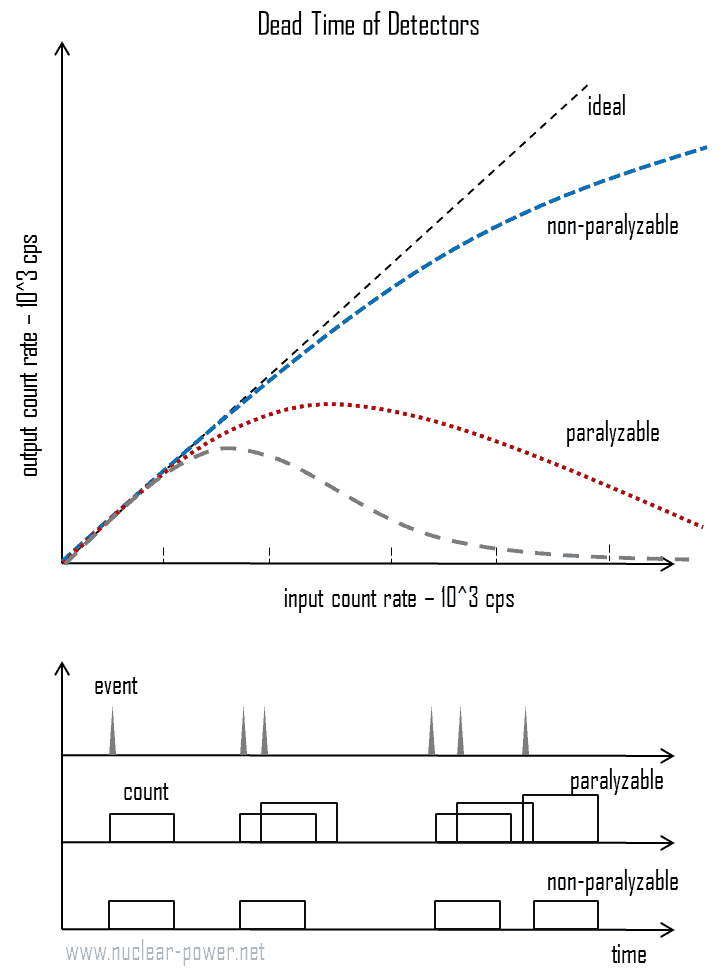 Because of the large avalanche induced by any ionization, a Geiger counter takes a long time (about 1 ms) to recover between successive pulses. Therefore, Geiger counters are not able to measure high radiation rates due to the “dead time” of the tube. The dead time is the time after each event during which the system is not able to record another event.
Because of the large avalanche induced by any ionization, a Geiger counter takes a long time (about 1 ms) to recover between successive pulses. Therefore, Geiger counters are not able to measure high radiation rates due to the “dead time” of the tube. The dead time is the time after each event during which the system is not able to record another event.
In a Geiger counter the fill gas of the chamber is an inert gas which is ionized by incident radiation, and a quench gas of 5–10% of an organic vapor or a halogen gas to prevent spurious pulsing by quenching the electron avalanches. The Geiger counter should not give spurious pulses, and should recover quickly to the passive state, ready for the next radiation event. Argon and helium are the most frequently used fill gases and allow for the detection of alpha, beta, and gamma radiation. For neutron detection He-3 and BF3 (Boron Trifluoride) are the most commonly employed gases.
However, for each electron collected in the chamber, there is a positively charged gas ion left over. These gas ions are heavy compared to an electron and move much more slowly. Free electrons are much lighter than the positive ions, thus, they are drawn toward the positive central electrode much faster than the positive ions are drawn to the chamber wall. The resulting cloud of positive ions near the electrode leads to distortions in gas multiplication. Eventually the positive ions move away from the positively charged central wire to the negatively charged wall and are neutralized by gaining an electron. These atoms then return to their ground state by emitting photons which in turn produce further ionisation and thereby spurious secondary discharges. The electrons produced by this ionization move toward the central wire and are multiplied en route. This pulse of charge is unrelated to the radiation to be detected and can set off a series of pulses. In practice the termination of the avalanche is improved by the use of “quenching” techniques.
The quenching gas molecules have a weaker affinity for electrons than the chamber gas does; therefore, the ionized atoms of the chamber gas readily take electrons from the quenching gas molecules. Thus, the ionized molecules of quenching gas reach the chamber wall instead of the chamber gas. The ionized molecules of the quenching gas are neutralized by gaining an electron, and the energy liberated does not cause further ionization, but causes dissociation of the molecule. This type of quenching is known as self-quenching or internal-quenching, since tubes stop the discharge without external assistance.
For Geiger counters, external quenching, sometimes called “active quenching” or “electronic quenching“, is also a possibility. Electronic quenching uses simplistic high speed control electronics to rapidly remove and re-apply the high voltage between the electrodes for a fixed time after each discharge peak in order to increase the maximum count rate and lifetime of the tube.
Special Reference: U.S. Department of Energy, Instrumantation and Control. DOE Fundamentals Handbook, Volume 2 of 2. June 1992.
We hope, this article, Quenching – Dead Time – Geiger Counters, helps you. If so, give us a like in the sidebar. Main purpose of this website is to help the public to learn some interesting and important information about radiation and dosimeters.